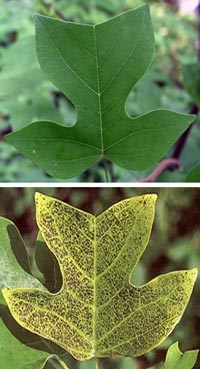What is an Air Pollution Garden?
These are gardens that serve as a living indication of the air quality in your immediate area. These gardens typically consist of bioindicator species, which will exhibit visible signs of high air pollution, and sensitive species, which will be affected by air pollution but may not have visible injuries. To learn more about bioindicators generally, check out the bioindicator wiki.
Most commonly, these gardens are designed to indicate the presence of O3, or ground-level ozone). Ozone in the stratosphere is essential to blocking harmful UV rays, but ground-level ozone has detrimental respiratory effects. Ground-level ozone is absorbed into the stomata during respiration and damages leaf tissue and interferes with photosynthesis, causing visible injuries to the leaf.
Air pollution gardens can be an interactive way of educating students and community members on the tangible impacts of air pollutants, in particular ground-level ozone.
Getting Started
Identifying Bioindicator Plants
Common ozone indicator plants include the cut-leaf coneflower, flowering dogwood, buttonbush, snap beans, soy beans, and milkweed.
The NPS has a more comprehensive list of ozone bioindicators and ozone sensitive species. When selecting species, keep these tips in mind:
- Where possible, select native plant species
- Select multiple species to take advantage of the differential sensitivities of different plants
- The growth period of the plants should coincide with the hottest months of the year since these months have the highest ozone concentrations
Impacts of Ozone
- Stippling (or purpling): Dot-like areas of tan, red, brown, purple, or black pigmentation on the upper surface of the leaf. Note that purpling/stippling is the only form of plant damage that is exclusively caused by ozone

Source: https://www.nps.gov/subjects/air/nature-ozone.htm - Chlorosis: Leaves losing chlorophyll and changing colors, usually to yellow
- Necrosis: Leaf cell death, tan or brown spots visible on both sides of leaf

Source: https://blogs.cornell.edu/livegpath/gallery/tomato/ozone-injury-on-tomato/ - Stunted leaf growth
- Premature leaf loss
- Symptoms do not occur in the veins
Garden Maintenance
As with any garden, air pollution gardens need to be actively maintained and properly cared for. In addition, keeping the garden neat and tidy will facilitate data collection. The National Park Service provides the following guidelines for maintaining biomonitoring gardens: Water each species appropriately Remove weeds regularly Prune dead branches and leaves
Collecting Data
How can you turn bioindicator gardens into data? One way is to estimate and record the amount of leaf damage over time. An example record could include the following information:
- Plant species
- Date
- Leaf number (recommend selecting several leaves from each plant)
- Damage type: Purpling, Chlorosis, Necrosis (*optional)
- Percent of leaf damaged
- NPS injury score
The NPS injury score can be calculated from the percentage of leaf damage using the conversion below:
| Rating | Description |
|---|---|
| 1 | 0% of leaf is affected |
| 2 | 1-6% of leaf is affected |
| 3 | 7-25% of leaf is affected |
| 4 | 26-50% of leaf is affected |
| 5 | 51-75% of leaf is affected |
| 6 | 76-100% of leaf is affected |
Since bioindicators can show cumulative impacts, you will likely see increasing damage over time. You can then plot the percentage damage over time and compare with ozone measurements if available.
 Source: https://ileaps.org/sites/default/files/B109_Danica_Lombardozzi.pdf
Source: https://ileaps.org/sites/default/files/B109_Danica_Lombardozzi.pdf
FAQ
How do I know if the plant damage is due to ozone or something else?
Check out this site.
How do I know if ozone is an issue in my area?
If you see smog, that’s a good indication that there’s a high level of ozone. AirNow is also a good place to check for daily ozone concentrations.
References
- National Park Service: Ozone Gardens - Air
- LAist: Growing an Air Pollution Garden
- National Park Service: List of Ozone Sensitive Species
- National Park Service: Ozone Bioindicator Gardens
- National Park Service: Air Quality Biogardens
- Hands on the Land: Ozone Garden Implementation Guide
- National Park Service: Handbook For Assessment Of Foliar Ozone Injury on Vegetation in the National Parks

1 Comments
@fongvania has marked @alejobonifacio as a co-author.
Reply to this comment...
Log in to comment
Login to comment.